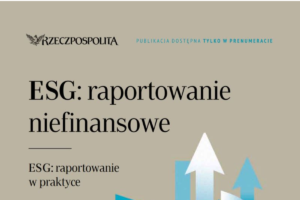Does sustainability pay off?

Many managers have the misconception that a company can have either profit or sustainability, but not both at the same time. Since sustainability is mainly associated with high expenditures and uncertain returns, Boards of Directors often focus only on fulfilling regulatory obligations, without thinking of it as an element of competitive advantage and a component of corporate value.
It is not surprising that sustainability is approached with caution since, for years, the growth of economic value was considered the primary goal of companies, and the interest of stakeholders was mainly limited to shareholders. And despite the fact that the concept of the triple bottom line, which takes into account beyond economics, environmental impact and people was established more than 40 years ago, it has not managed to successfully establish itself in our consciousness as a “horse worth betting on.”
At the beginning of this century, Teun van den Keuken, a Dutch reporter, was very surprised to discover that most of the cocoa beans on the world market are harvested by children and, moreover, that this problem has long been known to major chocolate manufacturers. As his protest against such practices did not yield the desired results, Teun decided to create his own brand of chocolate, whose mission was to produce 100% slave-free chocolate. The first batch of 5,000 chocolates sold out within a day, which made it possible to assess that even with a higher price, there were people willing to buy the product. During the first four years, the company grew slowly but steadily, reaching a turnover of about €1 million in 2009.
What practices has the company put in place to move toward its mission?
Analyzing the entire supply chain and the coverage margin account in the chocolate business, Teun discovered that it is unfairly distributed – bean prices for farmers are so low that they are unable to earn a living. Therefore, children are engaged in the harvest. As the biggest problem occurred at the stage of bean harvesting, the company introduced five rules:
- 100% traceable cocoa beans – usually, chocolate manufacturers buy a mixture of beans of unknown origin, which makes it impossible to fully analyze the supply chain and detect possible fraud. Here, full traceability of the supply all the way back to the source has been introduced, allowing us to keep an eye on standards and react immediately in case of irregularities,
- Higher bean prices – since prices that are too low do not allow farmers to earn a fair living, the company introduced a special payment model that additionally takes into account premiums for Fairtrade certification in situations where basic prices are insufficient,
- Establishment of cooperatives – in accordance with the principle of “bigger can do more,” communities of farmers have been formed, and they interact together not only in terms of sales strategies or representation of interests in the political arena but also share a common equipment base, thus reducing capital expenditures,
- Long-term contracts that can be terminated unilaterally by farmers and cooperatives, thus providing them with a sense of security (e.g., in the case of investments, there is no risk that the company will suddenly break the contract) and giving them the opportunity to break the contract if, for example, they get a better price offer from the competition,
In order to counter the exploitation of child labour, the Child Labor Monitoring and Remediation System (CLMRS) was created, which, in addition to monitoring and identifying cases of illegal child labour, helps find alternatives and prevent future abuse.
The purchase price of chocolate is, of course, higher than the products of global brands, as it is about EUR 6 per 180g bar. Nevertheless, its amateurs are not in short supply. In the 2022/23 fiscal year, the company’s turnover reached €150.2 million and the brand in question is Tony’s Chocolonely.
The above example shows us that it is possible to do good in a good way (the famous “doing good” and “doing well”) while earning a lot of money. Where can a company interested in sustainability transformation look for benefits? Here are some areas where you can identify the positive effects of the practices you implement and the projects you undertake:
Savings: Implementing environmentally friendly solutions can reduce energy, water and material costs. It will also have a positive impact on employee productivity and reduce employees rotation, Increased competitiveness: Sustainability can thus become an important differentiator in a competitive market and a source of additional revenue. Consumers are increasingly choosing products and services from companies that care about the environment and local communities,
Attracting and retaining talent and increasing employee engagement: Employees are more likely to engage with companies whose values align with their own. Sustainability can, therefore, become a motivating factor and increase employee loyalty. Nearly 80% of millennials say that a company’s ESG activities are crucial to them when choosing an employer. Representatives of Generation Z have a similar opinion Image enhancement: Sustainability is a topic that employees, customers, and investors are increasingly paying attention to. According to an E&Y survey, 97% of investors consider non-financial information important for decision-making, and 81% of consumers say companies should operate in a sustainable and socially responsible manner (Edelman Trust Barometer survey),
Innovation: Seeking solutions to social and environmental problems can stimulate innovation and lead to the development of new products and services,
as well as introduce sustainable practices within the organization. Here, it can be said that “the sky is the limit Better risk management: This can occur through, on the one hand, better identification and management of stakeholders throughout the supply chain, better chances of attracting attractive sources of financing, higher ratings, and greater resilience to regulatory changes.
Thinking about sustainable initiatives should not be treated as a compromise but as a smart strategy. What’s interesting is that 90% of global companies consider sustainability strategy important to remain competitive, but only 25% say they have found a clear business case for sustainability in their organization. Therefore, when thinking about the business case for sustainable transformation, it is worth asking two questions:
What will the company gain if it undergoes the transformation?
What does the company stand to lose if it does not make it?
Paying attention to both categories of effects can lead to interesting conclusions. It may turn out that the losses that a company could incur if it does not act will turn out to be severe and highly unprofitable.
Of course, sustainable transformation should be considered on a long-term horizon. As someone said sustainability is “not a sprint, but a marathon.” It requires the commitment of the entire team, and especially the boards of directors, and at the same time a long-range view. But it is worth the challenge, because the benefits of sustainable transformation are definitely worth the effort.

Iwona Chrzanowska is a business consultant, trainer, and academic lecturer. Expert in the areas of strategic management and portfolio and project management. A promoter of sustainable development, especially in the social area. She combines business with science PhD student at WSB University


